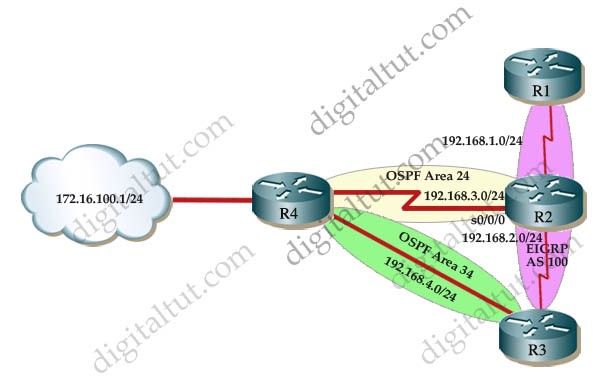Question: (Hope someone will contribute the detailed requirement of this sim!)
Some information I have gathered so far:
R2 is an ASBR for EIGRP 100 and OSPF AREA 24
R3 is an ASBR for EIGRP 100 and OSPF AREA 34
[note: so there are TWO separate areas on TWO separate ASBRS
thus you need to do redistribution on R2 and R3
R1 is ONLY in EIGRP 100, and is THE ONLY router you can ping from. R4 has a loopback interface that must be pinged from R1.
R4 is running OSPF and has redundant link to EIGRP network over R3 router.
Notice: You should make a ping from R1 to 172.16.100.1 network to make sure everything is working correctly.

Answer and Explanation:
Thanks to POONAM who send us the topology and configuration. He got 100% on EIGRP-OSPF lab so this solution is perfect! Please say thank to him and others who contribute this lab-sim!
SOLUTION from POONAM
First we need to find out 5 parameters (Bandwidth, Delay, Reliability, Load, MTU) of the s0/0/0 interface (the interface of R2 connected to R4) for redistribution :
R2#show interface s0/0/0
Write down these 5 parameters, notice that we have to divide the Delay by 10 because its metric unit is tens of microsecond. For example, we get Bandwidth=1544 Kbit, Delay=20000 us, Reliability=255, Load=1, MTU=1500 bytes then we would redistribute as follows:
R2#config terminal
R2(config)# router ospf 1
R2(config-router)# redistribute eigrp 100 metric-type 1 subnets
R2(config-router)#exit
R2(config-router)#router eigrp 100
R2(config-router)#redistribute ospf 1 metric 1544 2000 255 1 1500
(Notice: In fact, these parameters are just used for reference and we can use other parameters with no problem. Also, a candidate said that the simulator didn’t accept the Bandwidth of 1544; in that case, we can use a lower value, like 128.
If the delay is 20000us then we need to divide it by 10, that is 20000 / 10 = 2000)
For R3 we use the show interface fa0/0 to get 5 parameters too
R3#show interface fa0/0
For example we get Bandwidth=10000 Kbit, Delay=1000 us, Reliability=255, Load=1, MTU=1500 bytes
R3#config terminal
R3(config)#router ospf 1
R3(config-router)#redistribute eigrp 100 metric-type 1 subnets
R3(config)#exit
R3(config-router)#router eigrp 100
R3(config-router)#redistribute ospf 1 metric 10000 100 255 1 1500
Finally you should try to “show ip route” to see the 172.16.100.1 network (the network behind R4) in the routing table of R1 and make a ping from R1 to this network.
Maybe the “copy running-config startup-config” command will not work in this lab so don’t worry, just skip it.
WISH U A VERY BEST GUYS………..
GO ROCK…
Testing this lab on GSN3:
R1#show ip route
Codes: C - connected, S - static, R - RIP, M - mobile, B - BGP
D - EIGRP, EX - EIGRP external, O - OSPF, IA - OSPF inter area
N1 - OSPF NSSA external type 1, N2 - OSPF NSSA external type 2
E1 - OSPF external type 1, E2 - OSPF external type 2
i - IS-IS, su - IS-IS summary, L1 - IS-IS level-1, L2 - IS-IS level-2
ia - IS-IS inter area, * - candidate default, U - per-user static route
o - ODR, P - periodic downloaded static route
Gateway of last resort is not set
172.16.0.0/32 is subnetted, 1 subnets
D EX 172.16.100.1 [170/2681856] via 192.168.1.2, 00:11:28, Serial0/0
D EX 192.168.4.0/24 [170/2681856] via 192.168.1.2, 00:11:28, Serial0/0
C 192.168.1.0/24 is directly connected, Serial0/0
D 192.168.2.0/24 [90/2681856] via 192.168.1.2, 00:23:12, Serial0/0
D EX 192.168.3.0/24 [170/2681856] via 192.168.1.2, 00:11:28, Serial0/0


